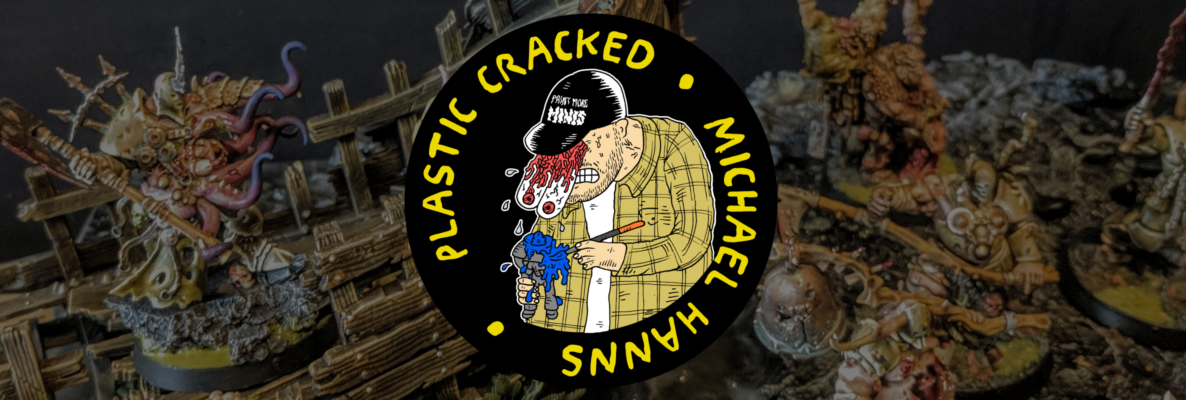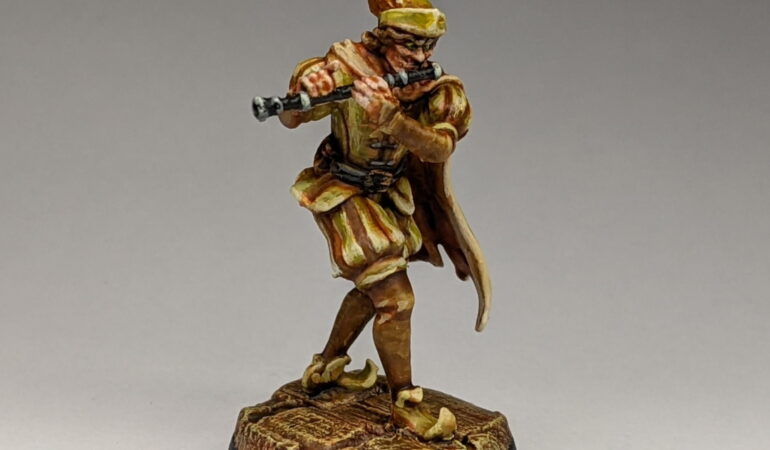
Hello folks, it’s been a long while since my last post, but I would like to assure you that I am very much still alive. There’s been a handful of reasons for my relative inaction on this blog – the most significant involving recently getting married – but I’m still here and I’m still painting miniatures.
Since the completion of my 6th Edition WHFB Skaven army, I’ve found it hard to get excited about knuckling down with a single project. For that, I blame this unit of Celestian Sacresants. It seemed like a good idea at the time. I’d just finished a big project, the minis looked great and rules wise were kind of a no brainer addition to my Sororitas. I had a good time putting them together, making subtle conversions and reposes to keep every mini looking a little unique. Everything was going great until it came time to put some paint on them.
I’m not entirely sure what happened, but these miniatures just absolutely destroyed my hobby mojo. My motivation dropped to the lowest it’s been since I got back into this hobby half a decade ago. No matter what I did, I just couldn’t muster the will to pick up a paint brush and advance the project. I’ve spoken before about how unenjoyable this colour scheme is to paint on Battle Sisters, but the Sacresants amplified those problems up to 11. Trying to achieve contrast on the filigreed power plant vents was a nightmare, and the additional wargear only served to increase the workload on these miniatures. It didn’t help that I had 10 of them to get through, either. In the end, this one unit took me about a month and a half to get through – granted, a great deal of that time was simply procrastination. Bizarrely, this is something I’ve never really had an issue with when it comes to painting miniatures.
Perhaps this burnout was inevitable; it certainly feels like it has been a long time coming. My once humble pile of shame has been creeping up in size over the past year, with several big new projects – a Rohan army for Middle-earth SBG, a full scale 54mm Inquisitor warband, the renovation and eventual completion of my childhood WHFB Dwarfs army and a sizeable upgrade to my Horus Heresy Daemons of the Ruinstorm – all building up behind me. There’s a lot to get done, and I just couldn’t motivate myself to take the first steps into either of them.
Instead, I decided to step back and take a break from hobby for a while. I relaxed and played some video games (Deathloop and Metroid Dread mostly), hung out with my wife, re-watched The Witcher and Attack on Titan ahead of their new seasons in December and January, walked the dog and just generally relaxed more with my free time. When I did eventually decide to pick up a paintbrush again, I decided to do something a little different to ease myself back into the swing of things.
Just before this hobby holiday happened, I’d played my first in person game of Dungeons and Dragons in well over a decade. During the 2nd big COVID lockdown, one way that some of my friends and I kept in touch was with a D&D campaign played over 20+ sessions using Roll20.net. This mostly came about – and probably lasted as long as it did – because there’s only so much shouting into the void you can do over Friday night Zoom calls. It wasn’t the first time we’d played D&D as a group before – I’d attempted to introduce it as a bit of a social experiment some years ago – but it was certainly the first time we’d ever managed to hold so many peoples attention for longer than 2 or 3 sessions. Some (okay, a lot) of this was thanks to lockdown – few of us had anything better to do on a Friday night, after all – but a lot of it was really held together by our friend Paul’s storytelling and forward planning. The man had really done his homework in setting up the adventure, knew it inside out and knew his universe well enough to improvise anything he hadn’t really prepared for. By the end of our campaign, we’d come to a satisfying conclusion with the story and it really felt like all of our characters had taken on a life of their own – this is exactly the kind of RPG experience that I’d always wanted but felt too awkward or inhibited to achieve before in person. When the story had come to a close and restrictions began to soften, most of us had agreed that it would be too much to expect for all of us to go straight into another campaign, but there was an appetite to pick it again periodically on a one-off basis.
So it came that a month or two ago, we finally returned to the Forgotten Realms – together, in person. Somewhat to my own surprise, it went well. Really well, actually. It was fun, maybe even more fun than we’d had playing it online. My fears that actual physical dice rolling and reading of character sheets would complicate things after the streamlined experience on Roll20 were (for the most part) unfounded. In fact, the only part I truly missed about playing online was the battle map – the ease and clarity of knowing where everyone was, what direction they were facing, who was in range of what. Of course, being the gigantic tabletop nerd I am, my mind was instantly abuzz with solutions – chief among them being playing with miniatures. The ‘town’ element of the game could be served just as well with a picture of a map, but it would be great to have a proper, gridded and – most importantly – three dimensional game board to play on while dungeon crawling. I am, of course, talking about dungeon tiles.
Of course, coming to a system like this from scratch is a lot of work. You’ve got to paint up the Dungeon Tiles themselves, paint miniatures for the party, paint miniatures for all the enemies in the dungeons, the boss fights, the terrain and items of interest in the dungeons themselves. Overwhelmed, I started thinking about the ways in which I could make life easier for myself. Did I have any miniatures from wargaming that I could reuse here, at least to get started? A lot of my Middle-earth miniatures were fairly ‘generic’ looking, but their smaller 25mm scale is a little generic next to most other 28mm minis. What about my Warhammer minis? The scale fits, but – at least with my Age of Sigmar armies – many of these are so uniquely stylised for that setting that it’s hard to use make them fit with a more ‘generic’ fantasy setting. Then I thought about my recent Skaven army – what about if I themed my adventure on a ratman menace, perhaps as the result of an evil wizard antagonist? I’d certainly have an awful lot of miniatures to choose from, in varying sizes and skillsets that could run parallel with other existing monsters. Are Ratmen really that different a threat to Goblins? Aren’t Rat Ogres basically just.. Ogres? Stormvermin would make excellent Hobgoblins or Gnolls. Giant rats and Rat Swarms would make perfect for little nuisances, perhaps even be employed to pull the parties attention to the places I want it. Even weapon teams like Ratling Guns could be used to create traps and or mini puzzles for the players to find creative solutions around. All I really needed to make this work was an antagonist for the party to fight against.
The easy way out here would be, of course, to use a Skaven character to represent the big bad in charge of things, but I had a better idea. Instead, I went hunting online for a suitably menacing miniature to play my central villain, eventually stumbling upon a very sinister looking Pied Piper miniature on an 3D printing Etsy store. The sculpt was brilliant, the price extremely reasonable and the print quality quite honestly blew me away. The miniature required next to no cleanup work and the details were as crisp and sharp as any cast resin or pewter miniature I’ve ever painted. I decided to play into his sinister aesthetic and paint him in the same Blanchitsu scheme that I developed for my Mordheim gang, the Squeaky Blinders – I figure he might get a little re-use as a Hired Sword or in a creative scenario for Mordheim down the line.
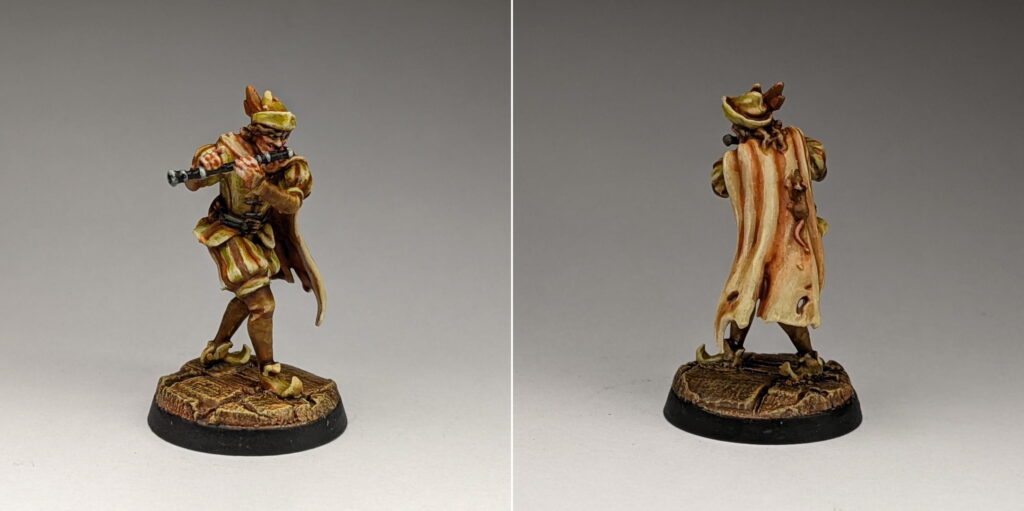
With the enemies mostly served by miniatures that I already own and have painted (for the most part), the scope of the project was starting to feel a whole lot less intimidating. Next, I went looking online for a good source of dungeon tiles.
Dungeon tiles is a vast, intimidating space in the miniature hobby that’s only gotten bigger with the advent of 3D printing. Tiles can range in size, detail and material and cover anything from punch out card floor tiles to resin cast behemoths that can set you back hundreds of pounds just to cover a decent chunk of your coffee table. Some companies – Dwarven Forge, for one example – understand that you’re going to need way more pieces than it’s practical to buy pre-cast and instead sell silicone moulds to allow you to cast your own. This seems like a great idea at first, until you start to consider that you’ll generally want to be getting a few of each mould (unless you fancy casting tiles one at a time). This is fine if you’re going to be casting tiles for your friends or selling them on to other hobbyists. but if you’re only planning on casting enough to make your own dungeon, chances are the cost/benefit ratios will still be a little out of whack.
Between these extremes, there is something of a sweet spot to be found. If you don’t have access to a good quality 3D printer, another good alternative is to find someone who will sell dungeon tiles pre-cast in plaster. I managed to find one such seller on eBay, whose product I found to be overall pretty good value and even arrived pre-painted (fairly simple drybrushing, but with a little more detail than you might normally expect) considerably cheaper than even the cheapest alternatives in cast resin/plastic, or even 3D printed tiles. The quality was solid, with about as much detail as you want from something like this – a flat but irregular surface for the 25mm floor tiles and nice cobbled wall sections that don’t look obviously duplicated. Visually, and from a value point of view, I find it incredibly hard to fault these tiles in any way shape or form. The seller – whose eBay shop you can find here – was very gracious and pleasant to deal with, to boot. I daresay the only thing I could fault these tiles on is that they’re a massive pain in the ass to store. Even good quality plaster can be prone to chipping if it rubs up against itself, particularly with the rough ‘stone’ finish of these tiles. The best solution I could think of was to pack everything in bubble wrap/foam, separated by type of tile (corner, wall, floor, door, etc) – it’s not ideal for a quick set up/pack away, but I’m just not sure I’d trust stacking these pieces together without worrying about chipping it as I put it away/took it out. To make matters worse, any chips are immediately noticeable due to the lack of pigment in the plaster itself – if anything comes off, you’re looking at a big bright white chip that’ll slaughter anyone’s immersion. I don’t know how practical it is to mix colouring into a plaster mix such as these and whether it might affect how it cures it not, but I daresay that if you’re thinking of casting any stone dungeon tiles of your own in plaster, I recommend looking into whether you can colour the plaster black or grey out of the box, as this will be a little less noticeable when it chips.
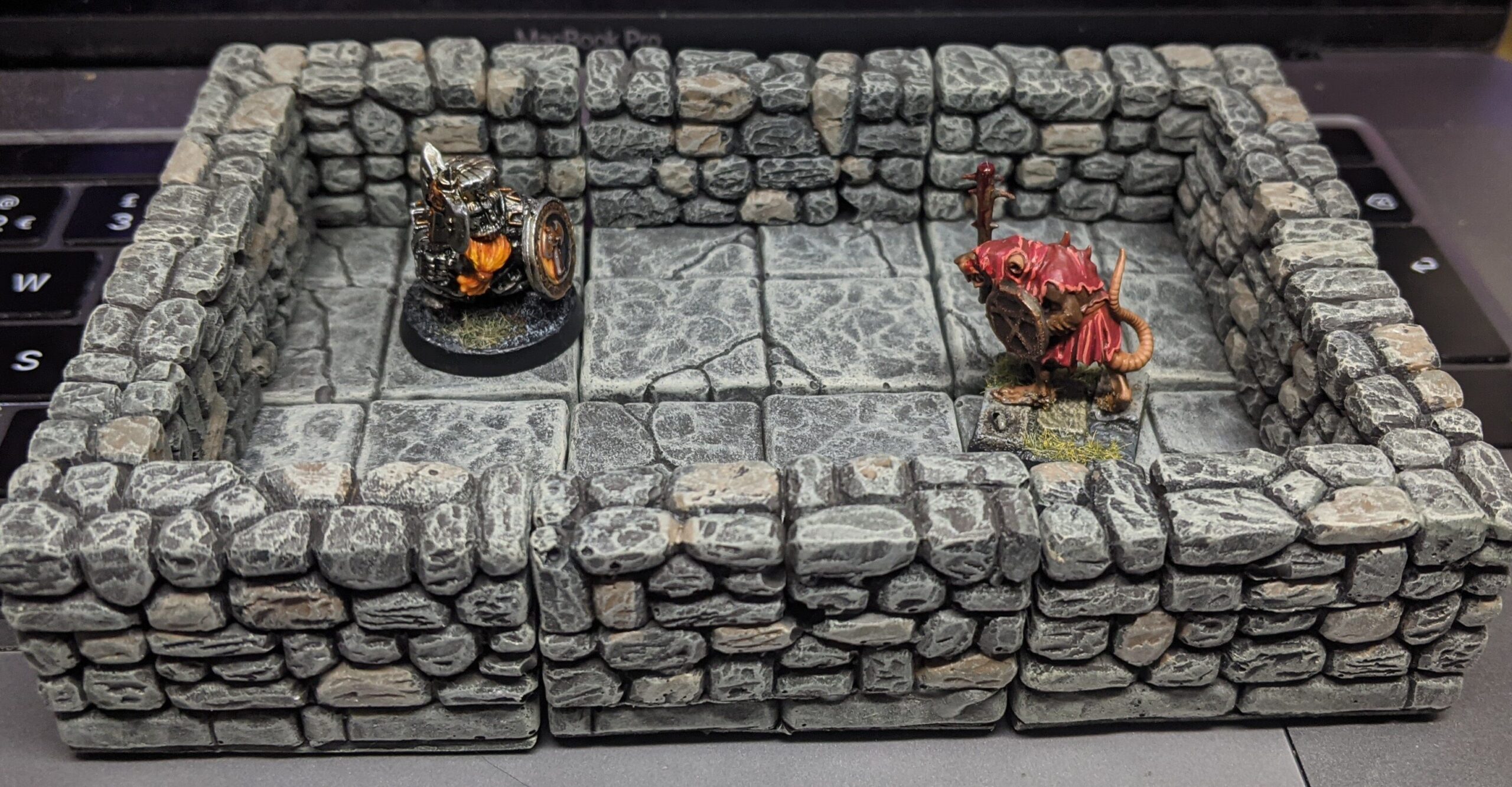
Regardless of their shortcomings, these tiles are versatile and really good value. At the time I’m posting this, the seller appears to have stopped selling them pre-painted (the upshot of which being they cost roughly half what I paid for them painted – making them extremely affordable for what they are), and I have to say I feel very fortunate to have found them when I did. It’s not the biggest task in the world washing and drybrushing a bunch of stone walls, but it sure is a chore – one I’ve mostly managed to luck out of doing. With the majority of the enemies in the bag and the dungeon tiles themselves ready out of the box, the only thing left to do in the dungeon was furnish it.
I looked at a wide variety of different sources of D&D Dungeon terrain, before eventually settling on TerrainCrate from Mantic. With TerrainCrate, Mantic have released inexpensive scatter terrain sets for a huge number of applications – everything from classic dungeons and gothic manors to modern day cities and building sites. In my case, I decided to pick up the Dungeon Essentials and Dungeon Depths to get me a good amount of options for a sprawling dungeon adventure – but I could easily see myself picking up the Gothic Manor set were I to run a Ravenloft-style adventure in the future.
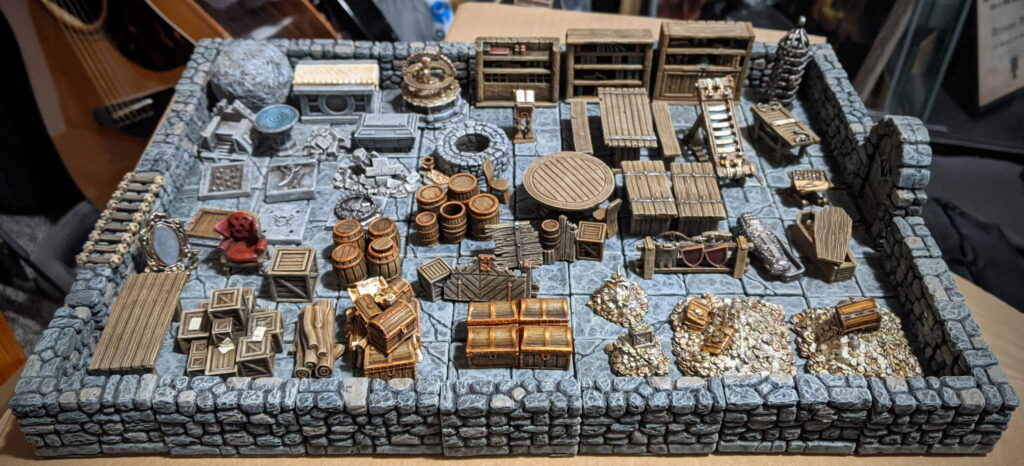
The main way in which Mantic has been able to keep the costs down on their TerrainCrate kits are by casting the pieces in what’s known as ‘restic’ – a kind of rubbery, cheap PVC-esque plastic material that has a bit of a soft finish and a little flex to it. The main advantage here is obviously cost, but I daresay it’s actually quite hard wearing as well. On something like terrain which is going to get knocked about a fair bit, I’d rather a bit of flex than hard and brittle – chair legs are less likely to snap off than on resin miniatures, and soft finishes like these tend to take paint really well. It certainly won’t be chipping off quite as easily as my plaster dungeon tiles or metal miniatures, that’s for sure. There are a couple of disadvantages though, the first of which is that the mould lines can be a bit gross in places and are considerably more annoying to remove than on just about every other material. A lot of the pieces also came a little warped out of the box, although this could be corrected and reset with hot water or a hairdryer in much the same way as resin.
As for the level of detail, well, there was pretty much the exact amount of detail that I want on a terrain piece on these – they look really good when painted, but they’re not so littered with details as to be tedious to paint en masse. The wood grain is nice and textured and responds really well to drybrushing and washes, while items like bookshelves have just enough little details to be interesting without looking too busy. All-in-all, it only really took me a couple of evenings to bash out the vast majority of bits from both of the kits to a simple but effective standard.
With the enemies and the dungeon now taken care of, the last part of the hobbying needing done was the party themselves. Being a one-off adventure, I figured I’d keep things simple and pre-roll a bunch of characters. One major benefit to doing this was that I could pick the miniatures first and make the race/class/background of the characters fit the miniature design. I thought I’d kill two birds with one stone here and finally get some paint on a few of the Mordheim Dramatis Personae that I’ve had collecting dust for over two years.
The first of these was Aenur, Sword of Twilight. This was a miniature that came free with an issue of White Dwarf around the launch of Mordheim (back when White Dwarf still did things like that). He’s got distinctly Elven features and a big billowing cloak almost entirely obscuring a set of chain and scale mail underneath, posed as if about to strike an unsuspecting victim. Aside from being hard as nails in Mordheim itself, the miniature has amazing utility in Dungeons and Dragons – he could just as easily represent a Rogue or a Fighter, but I decided to paint him a nice forest green to earmark him for a Ranger.
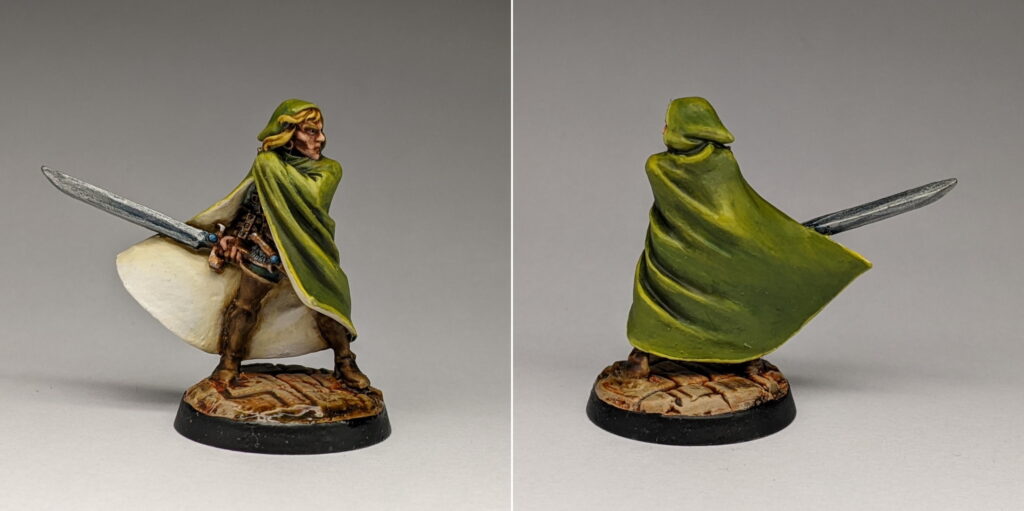
After Aenur came my next metal Dramatis Personae miniature – Nicodemus, or Not Gandalf, as I like to refer to him. I’ve seen this guy painted in all manner of colours, but I just couldn’t resist the urge to lean into the obvious Middle-earth influence of the sculpt.
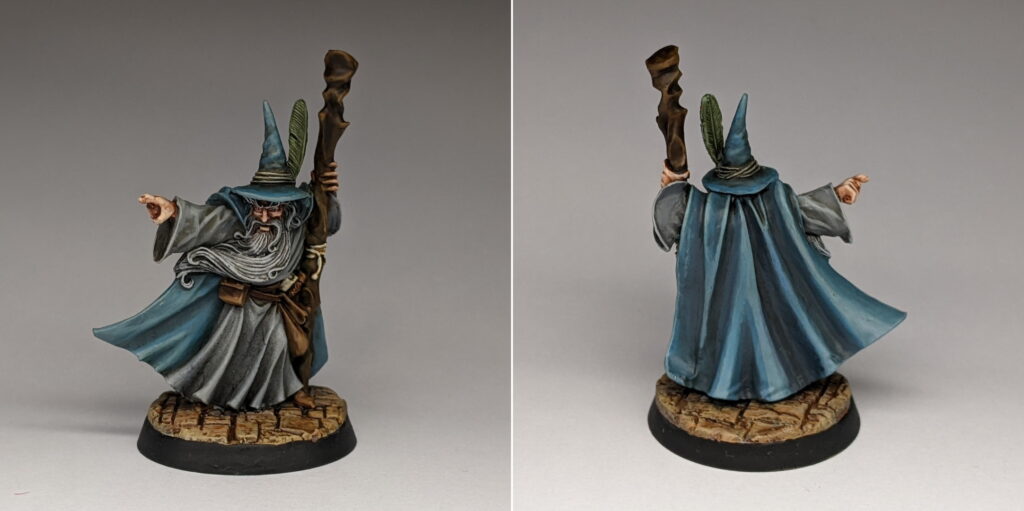
My last Mordheim miniature in the party is a rather special resin miniature – the original sculpt of Luthor (the narrator of the Mordheim rulebook), designed and commissioned by Tuomas Pirinen himself and produced by Heresy Lab in order to celebrate the 20th anniversary of Mordheim. This is a great little miniature that comes with 3 separate weapon options (bow, magic and greatsword) depending on how you want to play him, and comes with all new rules for using him in the game of Mordheim. Who said Mordheim was a dead game, eh? This limited edition miniature was sold at cost by Heresy Lab around a year ago, so of course I ordered three of them so that I could make one of each build. I feel better knowing at least one of them is finished now!
The cast of this miniature was absolutely brilliant. There was very little cleanup to do, and the details were crisp and very enjoyable to paint. If I had one complaint, I’d say that it borders on being a little too cluttered with detail in points for my tastes, but that’s entirely subjective. I absolutely love his adventurers pack filled with food, and his little cat poking it’s head out trying to reach the fish dangling from his waist. As with Aenur and Nicodemus, this made for a perfect adventurer miniature, and so Luthor joined the party as a Strength-based Fighter.

At this point, I’d run out of Mordheim miniatures and would have to look elsewhere for the rest of my party. I wanted my friends to have the option for a main-tank and so I pulled out the Ironbreaker Champion miniature from my Dwarfs army (still based for Age of Sigmar) for a quick tanky Fighter option. I didn’t want to spend too long repainting an old miniature, but I cleaned up some of the details and gave him a bit of a brighter beard to stand out more on the tabletop.
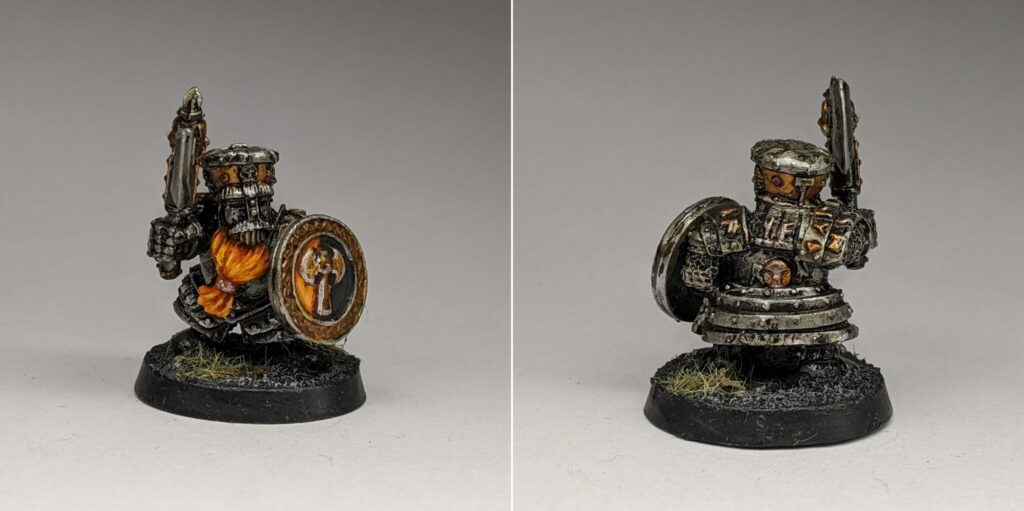
Now that I was out of suitable miniatures for the party, I decided to look online to fill out the rest – and the first place I knew I wanted to come back for another look was Heresy Lab. When last on their site to purchase Luthor, I discovered they had a range of miniatures called Citizens of the Old World, which absolutely captivated me. Here is a range of miniatures that look straight out of Mordheim, filling a wide range of rolls. You’ve got Witches, Mercenaries, Rat Catchers, Plague Doctors, Town Criers, Fanatics and even Children archetypes – absolutely perfect for helping fill out a D&D party or populating a town of civilians. I could go absolutely nuts on this website picking out all the bits and pieces for my games, but in the end I restrained myself and remained fairly minimal. So far, my party was looking a little bit much of a sausage fest, so I picked up two female miniatures that filled a couple of niches – a Sorceress and a Cleric or Paladin.
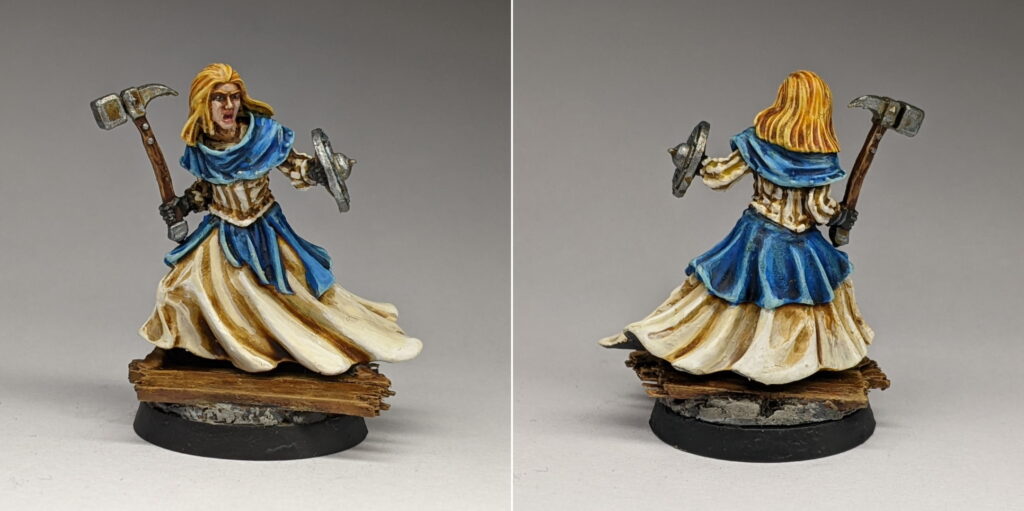
I had a basic idea of how I wanted these two characters to play out narratively, should players pick them both. The Sorceress was a village medicine woman of sorts but also dabbled in darker practices such as Necromancy – in a small settlement, beggars can’t be choosers. The Cleric/Paladin on the other hand, would be a Lawful Neutral sort of Zealot for some cookie-cutter ‘Protection’ God that would despise the sort of unnatural, morally grey magics practiced by the Sorceress. To that end, I wanted their paint jobs to look diametrically opposed.
For the Cleric/Paladin character, I mostly painted her using clean whites and creams and a nice, bright ‘water’ blue. I painted her using fairly conventional paints and techniques, using light sepia tones to shade her creamy white skirts and bodice, Vallejo Magic Blue as the base tone for her blues and bright blonde hair just to keep the miniature looking overall quite ‘light’ and clean.
The Sorceress on the other hand, I wanted to look a little more elemental and grungy, like she lives in a swamp. I gave her black hair and a Scarlet Red dress. Although Elfic Flesh was the same basic colour used to paint the underskirts of both of these models, I shaded the Sorceress primarily with AK Interactive Streaking Grime to give everything a bit more of a grimdark swampy look. Overall, I’m pretty happy with how they both turned out and the dichotomy between the two paint jobs.
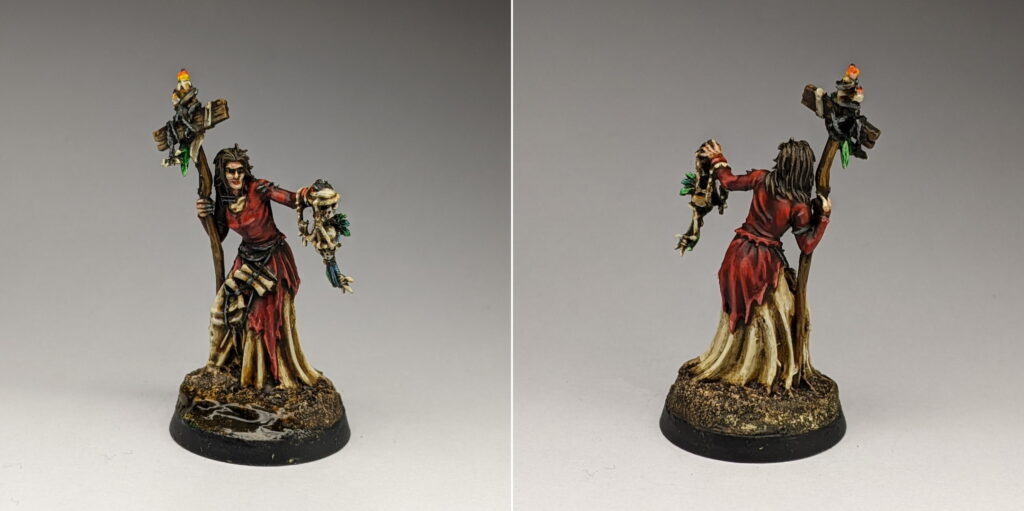
Now that the party had two Magic casters, two DPS fighters, a tank and a healer, the only major key ingredient missing from my Adventure Stew was, of course a Rogue. With the party almost entirely made of Humans (with an Elf and a Dwarf represented), I thought it would be a good idea to bring in a Halfling here. For this, I decided to brave the unfamiliar waters of Nolzur’s Marvellous Miniatures and picked up a pack of two1 female Halfling Rogues for the bargain price of a fiver.
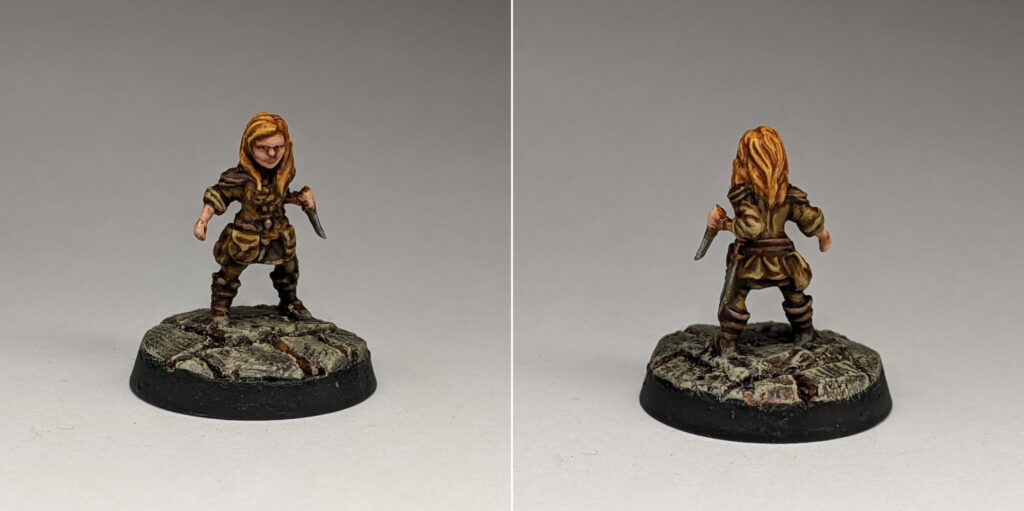
My first impressions of Nolzur’s minis? Yeah, pretty good for the price. Neither of the minis in the pack were the best looking sculpts I’d ever seen, and the restic or PVC or whatever it’s cast in makes for some pretty horrible mould lines to deal with. I’d also forgotten just how tiny Halflings actually are in Forgotten Realms – this Halfling Rogue wouldn’t look completely out of place next to my Hobbits from Middle-earth SBG. All that being said, I’d have been happy with either of these minis for a female Halfling Rogue, and the one I chose painted up pretty well all told. At five quid, it was an absolute bargain for a gaming miniature.
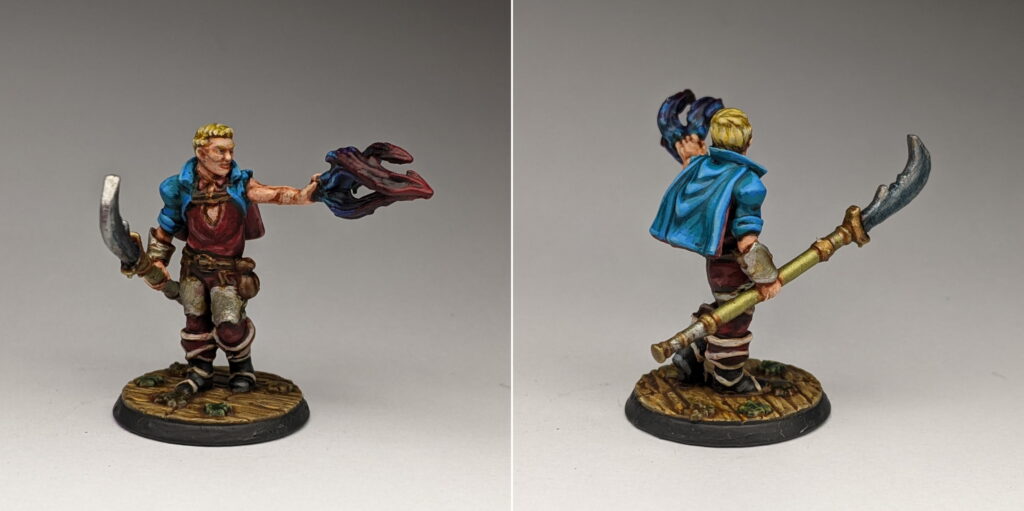
The final miniature that I painted for the party was a Human Warlock from HeroForge. For the uninitiated, HeroForge is a website that lets you design your own custom miniature from a whole host of different races, faces, builds, sizes and can be outfitted with almost any kind of wargear you could imagine. I’m not kidding here, you can do just about anything from make a Halfling Bard to a Science-Fiction Crow Person Gunslinger. Once you’ve designed your miniature, you can either order a print directly from HeroForge in a number of different materials or get an STL for home printing or for use in Tabletop Simulator. After our last adventure, I promised my party that if anyone wanted to buy their character, I would paint it up as a Christmas present. Well.. in the end, only two of my pals took me up on the offer – and one of them was the GM running the game who wanted a character for the next time he was a player. Here they both are, just in time for Christmas as promised2.
Interestingly enough, I kind of bookended painting the miniatures for this adventure with these HeroForge sculpts. My friends Tiefling Sorcerer pictured below was kind of the prelude to all of this, mostly because I’ve been holding onto this miniature for the guts of a year waiting for a gap in my painting schedule that would never come. When I finally decided to knuckle down and paint some minis for D&D, I figured painting his miniature first was the least I could do. On the flipside, my former GM’s character was the very last thing I painted, largely because we’ve spent the last year taking turns at either forgetting to bring it along or take it home every time we’ve seen each other over the last year.
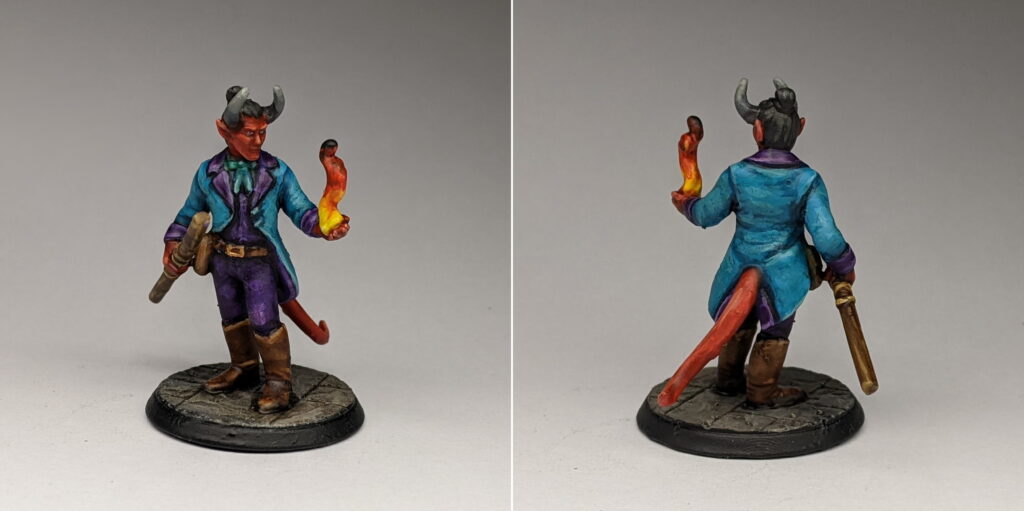
To paint, these HeroForge miniatures – both ‘premium plastic’ prints – are.. a little bit challenging. They have the same rubbery flex as the restic dungeon furnishings from TerrainCrate, but they lack the crisp detail. It’s not like they’re simple sculpts either – there’s plenty of sculpted interest on the models – but they are a little lacking in definition. You can still absolutely achieve solid results with these miniatures, but you do need to be a bit more deliberate than you would on something from Games Workshop or Wyrd Games. You can’t rely on washes or drybrushing to seek out the recesses or pick out sharp edges for you, because they don’t really have much in the way of either. Instead, I found myself focussing more on black lining with inks to help bring definition and separate different areas of colour. Aside from this (admittedly fairly key) difference in approach, the minis took paint pretty well. It was fun painting something just a little different. The 3D models produced by HeroForge lean more towards the cartoonish end of design – they look positively friendly compared to the darker, more realistic Heresy Lab designs. That’s not a criticism, but it could be something to be aware of depending on your personal preferences.
I said that the HeroForge Warlock was the last miniature I painted for the party, but in actuality the final member of the pool of adventurers in my Curse of the Pied Piper one shot is this Daemonette miniature that my wife painted two or three years ago.
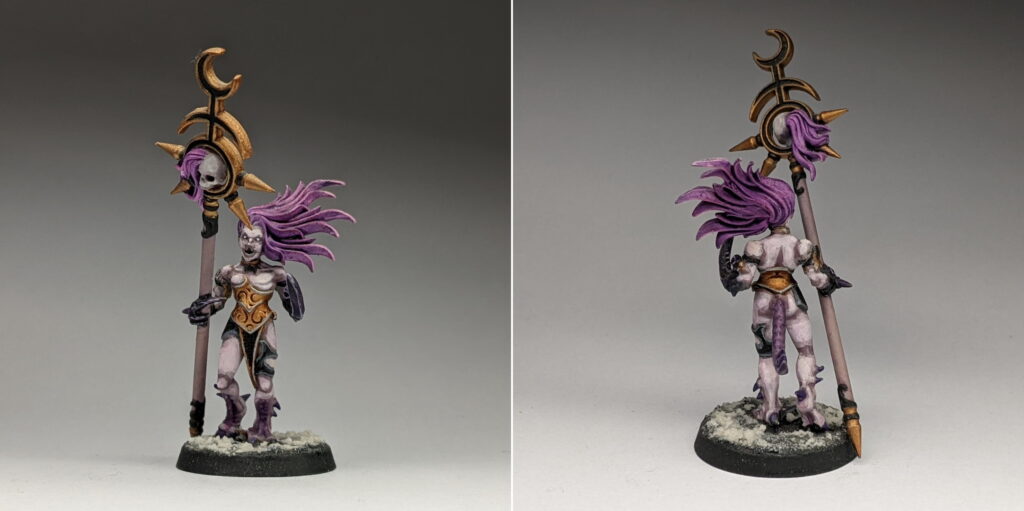
When I mentioned that I was going to let our former GM use his HeroForge mini, she asked if she could use the mini she painted in the adventure – how could I refuse? This absolutely counts as her playing a miniature game with me. I figured a good match would be to make her a Tiefling Druid who prefers to spend her time underwater with the aquatic animals – hence the infernal look and the crustacean claws. Nailed it.
So there we have it – 9 party members, a furnished dungeon populated with Rats and Ratmen and a big bad villain to boot. Now all I have to do is roll up the character sheets and map out the dungeon. How hard could it be?
Until next time, thanks for reading and happy roleplaying!
1 I kind of hate this approach that Wizards took with packaging these miniatures. Although it’s nice to have a choice of two different poses in the pack, in almost every single situation I’m only ever going to want one of that exact race/class/gender combination. If you’re going to give me two minis with the same race/class in a pack, at least give me a male and a female or something. These minis are a bargain at the price, but you get what you pay for, and it’s a bit of a false economy when you’re also factoring in redundancy.
2 No, really. Look, I only said it would be ready for Christmas, I didn’t say it would be ready for Christmas 2020…
